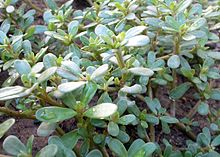Portulaca oleracea
| Portulaca oleracea | |
|---|---|
 |
|
| Scientific classification | |
| Kingdom: | Plantae |
| (unranked): | Angiosperms |
| (unranked): | Eudicots |
| (unranked): | Core eudicots |
| Order: | Caryophyllales |
| Family: | Portulacaceae |
| Genus: | Portulaca |
| Species: | P. oleracea |
| Binomial name | |
|
Portulaca oleracea L. |
|
| Nutritional value per 100 g (3.5 oz) | |
|---|---|
| Energy | 84 kJ (20 kcal) |
|
3.39 g
|
|
|
0.36 g
|
|
|
2.03 g
|
|
| Vitamins | |
| Vitamin A | 1320 IU |
| Thiamine (B1) |
(4%)
0.047 mg |
| Riboflavin (B2) |
(9%)
0.112 mg |
| Niacin (B3) |
(3%)
0.48 mg |
| Vitamin B6 |
(6%)
0.073 mg |
| Folate (B9) |
(3%)
12 μg |
| Vitamin C |
(25%)
21 mg |
| Vitamin E |
(81%)
12.2 mg |
| Minerals | |
| Calcium |
(7%)
65 mg |
| Iron |
(15%)
1.99 mg |
| Magnesium |
(19%)
68 mg |
| Manganese |
(14%)
0.303 mg |
| Phosphorus |
(6%)
44 mg |
| Potassium |
(11%)
494 mg |
| Zinc |
(2%)
0.17 mg |
| Other constituents | |
| Water | 92.86 g |
|
|
|
|
|
| Percentages are roughly approximated using US recommendations for adults. Source: USDA Nutrient Database |
|
Portulaca oleracea (common purslane, also known as verdolaga, pigweed, little hogweed, red root, pursley) is an annual succulent in the family Portulacaceae, which may reach 40 centimetres (16 in) in height.
Approximately forty cultivars are currently grown.
It has an extensive distribution, assumed to be mostly anthropogenic, throughout the Old World extending from North Africa and Southern Europe through the Middle East and the Indian Subcontinent to Malesia and Australasia. The species status in the New World is uncertain: in general, it is considered an exotic weed, however, there is evidence that the species was in Crawford Lake deposits (Ontario) in 1350-1539, suggesting that it reached North America in the pre-Columbian era. Scientists suggested that the plant was already eaten by native Americans, who spread its seeds. How it reached the New World is currently unknown. It is naturalised elsewhere, and in some regions is considered an introduced weed.
It has smooth, reddish, mostly prostrate stems and alternate leaves clustered at stem joints and ends. The yellow flowers have five regular parts and are up to 6 millimetres (0.24 in) wide. Depending upon rainfall, the flowers appear at any time during the year. The flowers open singly at the center of the leaf cluster for only a few hours on sunny mornings. Seeds are formed in a tiny pod, which opens when the seeds are mature. Purslane has a taproot with fibrous secondary roots and is able to tolerate poor compacted soils and drought.
...
Wikipedia
